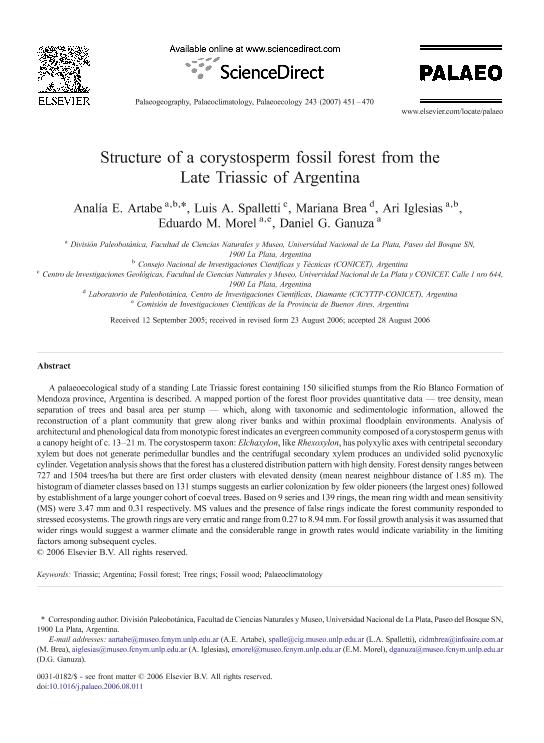Mostrar el registro sencillo del ítem
dc.contributor.author
Artabe, Analia Emilia Eva

dc.contributor.author
Spalletti, Luis Antonio

dc.contributor.author
Brea, Mariana

dc.contributor.author
Iglesias, Ari

dc.contributor.author
Morel, Eduardo Manuel

dc.contributor.author
Ganuza, Daniel Gustavo

dc.date.available
2019-04-09T21:45:15Z
dc.date.issued
2007-01
dc.identifier.citation
Artabe, Analia Emilia Eva; Spalletti, Luis Antonio; Brea, Mariana; Iglesias, Ari; Morel, Eduardo Manuel; et al.; Structure of a corystosperm fossil forest from the Late Triassic of Argentina; Elsevier Science; Palaeogeography, Palaeoclimatology, Palaeoecology; 243; 3-4; 1-2007; 451-470
dc.identifier.issn
0031-0182
dc.identifier.uri
http://hdl.handle.net/11336/73607
dc.description.abstract
A palaeoecological study of a standing Late Triassic forest containing 150 silicified stumps from the Río Blanco Formation of Mendoza province, Argentina is described. A mapped portion of the forest floor provides quantitative data - tree density, mean separation of trees and basal area per stump - which, along with taxonomic and sedimentologic information, allowed the reconstruction of a plant community that grew along river banks and within proximal floodplain environments. Analysis of architectural and phenological data from monotypic forest indicates an evergreen community composed of a corystosperm genus with a canopy height of c. 13-21 m. The corystosperm taxon: Elchaxylon, like Rhexoxylon, has polyxylic axes with centripetal secondary xylem but does not generate perimedullar bundles and the centrifugal secondary xylem produces an undivided solid pycnoxylic cylinder. Vegetation analysis shows that the forest has a clustered distribution pattern with high density. Forest density ranges between 727 and 1504 trees/ha but there are first order clusters with elevated density (mean nearest neighbour distance of 1.85 m). The histogram of diameter classes based on 131 stumps suggests an earlier colonization by few older pioneers (the largest ones) followed by establishment of a large younger cohort of coeval trees. Based on 9 series and 139 rings, the mean ring width and mean sensitivity (MS) were 3.47 mm and 0.31 respectively. MS values and the presence of false rings indicate the forest community responded to stressed ecosystems. The growth rings are very erratic and range from 0.27 to 8.94 mm. For fossil growth analysis it was assumed that wider rings would suggest a warmer climate and the considerable range in growth rates would indicate variability in the limiting factors among subsequent cycles. © 2006 Elsevier B.V. All rights reserved.
dc.format
application/pdf
dc.language.iso
eng
dc.publisher
Elsevier Science

dc.rights
info:eu-repo/semantics/openAccess
dc.rights.uri
https://creativecommons.org/licenses/by-nc-sa/2.5/ar/
dc.subject
Argentina
dc.subject
Fossil Forest
dc.subject
Fossil Wood
dc.subject
Palaeoclimatology
dc.subject
Tree Rings
dc.subject
Triassic
dc.subject.classification
Paleontología

dc.subject.classification
Ciencias de la Tierra y relacionadas con el Medio Ambiente

dc.subject.classification
CIENCIAS NATURALES Y EXACTAS

dc.title
Structure of a corystosperm fossil forest from the Late Triassic of Argentina
dc.type
info:eu-repo/semantics/article
dc.type
info:ar-repo/semantics/artículo
dc.type
info:eu-repo/semantics/publishedVersion
dc.date.updated
2019-03-27T13:57:26Z
dc.journal.volume
243
dc.journal.number
3-4
dc.journal.pagination
451-470
dc.journal.pais
Países Bajos

dc.journal.ciudad
Amsterdam
dc.description.fil
Fil: Artabe, Analia Emilia Eva. Consejo Nacional de Investigaciones Científicas y Técnicas; Argentina. Universidad Nacional de La Plata. Facultad de Ciencias Naturales y Museo; Argentina
dc.description.fil
Fil: Spalletti, Luis Antonio. Consejo Nacional de Investigaciones Científicas y Técnicas; Argentina. Universidad Nacional de La Plata. Facultad de Ciencias Naturales y Museo; Argentina
dc.description.fil
Fil: Brea, Mariana. Provincia de Entre Ríos. Centro de Investigaciones Científicas y Transferencia de Tecnología a la Producción. Universidad Autónoma de Entre Ríos. Centro de Investigaciones Científicas y Transferencia de Tecnología a la Producción. Consejo Nacional de Investigaciones Científicas y Técnicas. Centro Científico Tecnológico Conicet - Santa Fe. Centro de Investigaciones Científicas y Transferencia de Tecnología a la Producción; Argentina
dc.description.fil
Fil: Iglesias, Ari. Consejo Nacional de Investigaciones Científicas y Técnicas; Argentina. Universidad Nacional de La Plata. Facultad de Ciencias Naturales y Museo; Argentina
dc.description.fil
Fil: Morel, Eduardo Manuel. Universidad Nacional de La Plata. Facultad de Ciencias Naturales y Museo; Argentina. Provincia de Buenos Aires. Gobernación. Comisión de Investigaciones Científicas; Argentina
dc.description.fil
Fil: Ganuza, Daniel Gustavo. Universidad Nacional de La Plata. Facultad de Ciencias Naturales y Museo; Argentina
dc.journal.title
Palaeogeography, Palaeoclimatology, Palaeoecology

dc.relation.alternativeid
info:eu-repo/semantics/altIdentifier/doi/http://dx.doi.org/10.1016/j.palaeo.2006.08.011
dc.relation.alternativeid
info:eu-repo/semantics/altIdentifier/url/https://linkinghub.elsevier.com/retrieve/pii/S0031018206004949
Archivos asociados
